.gif)
List of moths of Great Britain (Arctiidae)
Encyclopedia
The family
Arctiidae
—the tiger moths, ermines, "footmen" and related species—is represented by 32 species in Great Britain
:
Subfamily Lithosiinae
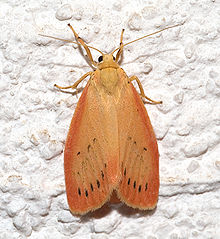
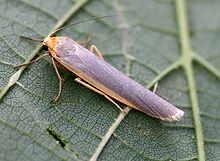
Subfamily Arctiinae
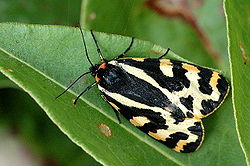
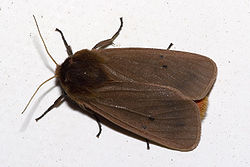
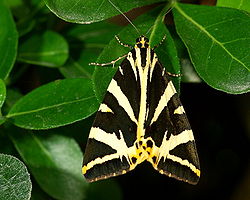
Species listed in the 2007 UK Biodiversity Action Plan
(BAP) are indicated by a double-dagger symbol (‡)—species so listed for research purposes only are also indicated with an asterisk (‡*).
Family (biology)
In biological classification, family is* a taxonomic rank. Other well-known ranks are life, domain, kingdom, phylum, class, order, genus, and species, with family fitting between order and genus. As for the other well-known ranks, there is the option of an immediately lower rank, indicated by the...
Arctiidae
Arctiidae
Arctiidae is a large and diverse family of moths with around 11,000 species found all over the world, including 6,000 neotropical species. This family includes the groups commonly known as tiger moths , which usually have bright colours, footmen , lichen moths and wasp moths...
—the tiger moths, ermines, "footmen" and related species—is represented by 32 species in Great Britain
Great Britain
Great Britain or Britain is an island situated to the northwest of Continental Europe. It is the ninth largest island in the world, and the largest European island, as well as the largest of the British Isles...
:
Subfamily LithosiinaeLithosiinaeThe Lithosiinae are a subfamily of moths.-Systematics:The systematics of the Lithosiinae are in need of revision. For example, the proposed tribes Afridini, Cisthenini, Endrosini and Eudesmini require validation and delimitation of content...

- Thumatha senexThumatha senexThe Round-winged Muslin is a moth of the Arctiidae family. It is found in northern and central Europe, the Alps, northern Asia Minor, the Crimea and south-western Siberia....
Round-winged Muslin — south, central & north (localized) - Setina irrorellaSetina irrorellaThe Dew Moth is a moth of the family Arctiidae. It is found in Europe and Northern Asia.The wingspan is 27–33 mm. The length of the forewings is 11–18 mm. The moth flies May to July depending on the location....
Dew Moth — south & north-west (Nationally Scarce A) - Miltochrista miniataMiltochrista miniataThe Rosy Footman is a moth of the family Arctiidae. It is found in the temperate parts of the Palearctic ecozone.The wingspan is 23–27 mm. The moth flies from June to September depending on the location....
Rosy Footman — south & central (localized) - Nudaria mundanaNudaria mundanaThe Muslin Footman is a moth of the family Arctiidae. It is found in Europe and Anatolia.The wingspan is 19–23 mm. The length of the forewings 10–12 mm. The moth flies from June to August depending on the location....
Muslin Footman — throughout (localized) - Atolmis rubricollisAtolmis rubricollisThe Red-necked Footman is a moth of the family Arctiidae. It is found in Europe, Siberia and China.The wingspan is 25-35 mm. The length of the forewings is 15-18 mm. The moth flies May to July depending on the location....
Red-necked Footman — south, west-central & north (localized) - Cybosia mesomellaCybosia mesomellaThe Four-dotted Footman is a moth of the family Arctiidae. It is found in the Palearctic ecozone.The wingspan is 25–33 mm. The moth flies June to August depending on the location....
Four-dotted Footman — throughout (localized) - Pelosia muscerdaPelosia muscerdaThe Dotted Footman is a species of moth of the family Arctiidae. It is found in the Palearctic ecozone.The wingspan is 24–28 mm. The moth flies from June to September depending on the location....
Dotted Footman — east (Red Data Book) - Pelosia obtusa Small Dotted Footman — east (Red Data Book)

- Eilema sororculaEilema sororculaThe Orange Footman is a moth of the family Arctiidae. It is found in Europe, South-East Asia and Anatolia.The wingspan is 27–30 mm. The moth flies from April to June depending on the location.The larvae feed on Lichen....
Orange Footman — south (localized) - Eilema griseolaEilema griseolaThe Dingy Footman is a moth of the family Arctiidae. It is found in Europe and North and South-East Asia.The wingspan is 32–40 mm. The moth flies from May to August depending on the location.The larvae feed on Lichen....
Dingy Footman — south & central - Eilema caniolaEilema caniolaThe Hoary Footman is a moth of the family Arctiidae. It is found in North Africa, Western and Southern Europe and Eastern Europe up to Russia.The wingspan is 28–35 mm. The moth flies from July to September depending on the location....
Hoary Footman — south-west (Nationally Scarce B) - Eilema pygmaeolaEilema pygmaeolaThe Pigmy Footman is a moth of the Arctiidae family. It is found in the western half of the Palearctic ecozone.The wingspan is 24-28 mm. There is one generation per year with adults on wing from June to August....
Pygmy Footman (Red Data Book) - Eilema pygmaeola pygmaeola — east
- Eilema pygmaeola pallifrons — south-east
- Eilema complanaEilema complanaThe Scarce Footman is a moth of the family Arctiidae. It is found in Europe.The wingspan is 28–35 mm. The moth flies from June to August depending on the location....
Scarce Footman — south & central (localized) - Eilema complana f. sericea Northern Footman — west-central (Red Data Book)
- Eilema depressaEilema depressaThe Buff Footman is a moth of the family Arctiidae. It is found from western Europe through Asia to Japan.The length of the forewings is 15–17 mm. The moth flies from June to September depending on the location....
Buff Footman — south & central (localized) - Eilema lurideola Common Footman — south, central & north
- Lithosia quadraLithosia quadraThe Four-spotted Footman, Lithosia quadra, is a moth of the family Arctiidae. It is found in Southern and Central Europe up to the Amur River. It is also found in the South of Great Britain and Scandinavia....
Four-spotted Footman — immigrant to south-west (Nationally Scarce A)
Subfamily ArctiinaeArctiinaeThe Arctiinae are a subfamily of moths.-Systematics:The systematics of the Arctiinae are in need of revision and depends significantly on a personal view of an author. In any case, Arctiinae is a monophyletic group with a clear autapomorphic character - a presence of anal glands in females. On the...



-
[ Spiris striataSpiris striataThe Feathered Footman is a moth of the family Arctiidae. It is found in Europe, Anatolia, Kazakhstan, Siberia and Mongolia .The wingspan is 30–35 mm. The moth flies May to August depending on the location....
Feathered Footman — uncertain status] - Coscinia cribrariaCoscinia cribrariaThe Speckled Footman is a moth of the family Arctiidae. It is found in Europe except the most northern parts; also in north-western Africa, Kazakhstan, Siberia, Mongolia, north-western and north-eastren China....
Speckled Footman ‡ - Coscinia cribraria bivittata — south (Red Data Species)
- Coscinia cribraria arenaria — immigrant
- Utetheisa pulchellaUtetheisa pulchellaThe Crimson-speckled Flunkey is a moth of the family Arctiidae. It is found in Africa, Southern Europe, Central and Southern Asia and Australia.The wingspan is 29-42 mm....
Crimson Speckled — immigrant - Utetheisa bellaUtetheisa bellaThe Ornate Moth or Bella Moth is a moth of the Arctiidae family. It is found in the Eastern United States.The wingspan is 33-46 mm....
Beautiful Utetheisa — probable rare immigrant (though possibly an import) - Parasemia plantaginisParasemia plantaginisThe Wood Tiger is a moth of the family Arctiidae. Several subspecies are found in the Holarctic ecozone south to Anatolia, Transcaucasus, northern Iran, Kazakhstan, Mongolia, China, Korea and Japan. One subspecies is endemic to North America.The wingspan is 32–38 mm...
Wood Tiger - Parasemia plantaginis plantaginis — throughout
- Parasemia plantaginis insularum — Shetland, Orkney & northern ScotlandScotlandScotland is a country that is part of the United Kingdom. Occupying the northern third of the island of Great Britain, it shares a border with England to the south and is bounded by the North Sea to the east, the Atlantic Ocean to the north and west, and the North Channel and Irish Sea to the...
- Arctia caja Garden Tiger — throughout ‡*
- Arctia villica britannicaArctia villicaThe Cream-spot Tiger is a moth of the family Arctiidae. It is found in Europe, Anatolia, western and northern Iran, West Siberia and North Africa.The wingspan is 60–68 mm...
Cream-spot Tiger — south (localized) - Hyphoraia testudinaria Patton's Tiger — vagrantVagrancy (biology)Vagrancy is a phenomenon in biology whereby individual animals appear well outside their normal range; individual animals which exhibit vagrancy are known as vagrants. The term accidental is sometimes also used...
: 2 records, SussexSussexSussex , from the Old English Sūþsēaxe , is an historic county in South East England corresponding roughly in area to the ancient Kingdom of Sussex. It is bounded on the north by Surrey, east by Kent, south by the English Channel, and west by Hampshire, and is divided for local government into West...
& DevonDevonDevon is a large county in southwestern England. The county is sometimes referred to as Devonshire, although the term is rarely used inside the county itself as the county has never been officially "shired", it often indicates a traditional or historical context.The county shares borders with... - Diacrisia sannioDiacrisia sannioThe Clouded Buff is a moth of the family Arctiidae. It is found in the Palearctic ecozone, but not in North Africa and South-East Asia.The wingspan is 35-50 mm. The moth flies June to July depending on the location....
Clouded Buff — throughout (localized) - Spilosoma lubricipedaSpilosoma lubricipedaThe White Ermine is a moth of the family Arctiidae. It is found throughout the temperate belt of Eurasia from Europe through Kazakhstan and Southern Siberia to Amur Region, China, Korea and Japan. In China several sibling species occur.The wingspan is 34-48 mm. Wing pattern is very variable, from...
White Ermine — throughout ‡* - Spilosoma luteum Buff Ermine — south, central & north ‡*
- Spilosoma urticaeSpilosoma urticaeThe Water Ermine is a moth of the family Arctiidae. It is found in temperate belt of the Palearctic ecozone like similar Spilosoma lubricipedum, but prefer more dry biotopes. So, S. urticae is more abundant in steppes and it is the single Spilosoma species in Central Asia.The wingspan is 38-46 mm....
Water Ermine — south-east (Nationally Scarce B) - Diaphora mendicaDiaphora mendicaThe Muslin Moth is a moth of the family Arctiidae. It is found in the Palearctic ecozone east to Baikal Lake.The wingspan is 28–38 mm. There is clear sexual dimorphism in the imago, with the male having a brownish gray colour and a forewing length of 14–17 mm, and the female being white...
Muslin Moth — south, central & north - Phragmatobia fuliginosaPhragmatobia fuliginosaThe Ruby Tiger is a moth of the family Arctiidae. It is found in Europe. There are a number of recognized subspecies, such as P. f. melitensis in Malta and P. f. borealis in Scotland.The wingspan is 35–45 mm...
Ruby Tiger - Phragmatobia fuliginosa borealis — north
- Phragmatobia fuliginosa fuliginosa — south & central
-
[ Pyrrharctia isabella Isabelline Tiger — accidental introduction] -
[ Halysidota moeschleri — possible rare transatlantic immigrant or import] - Euplagia quadripunctariaEuplagia quadripunctariaThe Jersey Tiger, Euplagia quadripunctaria, is a moth of the family Arctiidae. It is found in Central Europe, Southern England, the Channel Islands, Southern Europe, West Russia, South Urals, Asia Minor, the Near East, Caucasus, South Turkmenistan, Iran and Rhodes.The wingspan is . The moth flies...
Jersey Tiger — south-west - Callimorpha dominula Scarlet Tiger — south-west (localized)
- Tyria jacobaeae Cinnabar — south, central & north ‡*
-
[ Hypercompe scribonia Great Leopard — probable import]
Species listed in the 2007 UK Biodiversity Action Plan
United Kingdom Biodiversity Action Plan
The United Kingdom Biodiversity Action Plan is the governmental response to the Convention on Biological Diversity signed in 1992. When the Biodiversity Action Plans were first published in 1994, the conservation of 391 species and 45 habitats was covered. 1,150 species and 65 habitats are...
(BAP) are indicated by a double-dagger symbol (‡)—species so listed for research purposes only are also indicated with an asterisk (‡*).

